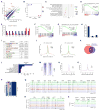Dual Requirement of CHD8 for Chromatin Landscape Establishment and Histone Methyltransferase Recruitment to Promote CNS Myelination and Repair
- PMID: 29920279
- PMCID: PMC6063525
- DOI: 10.1016/j.devcel.2018.05.022
Dual Requirement of CHD8 for Chromatin Landscape Establishment and Histone Methyltransferase Recruitment to Promote CNS Myelination and Repair
Abstract
Disruptive mutations in chromatin remodeler CHD8 cause autism spectrum disorders, exhibiting widespread white matter abnormalities; however, the underlying mechanisms remain elusive. We show that cell-type specific Chd8 deletion in oligodendrocyte progenitors, but not in neurons, results in myelination defects, revealing a cell-intrinsic dependence on CHD8 for oligodendrocyte lineage development, myelination and post-injury remyelination. CHD8 activates expression of BRG1-associated SWI/SNF complexes that in turn activate CHD7, thus initiating a successive chromatin remodeling cascade that orchestrates oligodendrocyte lineage progression. Genomic occupancy analyses reveal that CHD8 establishes an accessible chromatin landscape, and recruits MLL/KMT2 histone methyltransferase complexes distinctively around proximal promoters to promote oligodendrocyte differentiation. Inhibition of histone demethylase activity partially rescues myelination defects of CHD8-deficient mutants. Our data indicate that CHD8 exhibits a dual function through inducing a cascade of chromatin reprogramming and recruiting H3K4 histone methyltransferases to establish oligodendrocyte identity, suggesting potential strategies of therapeutic intervention for CHD8-associated white matter defects.
Keywords: CHD8; KMT2/MLL; autism; chromatin landscape; chromatin remodeling; histone methyltransferase; myelin repair; myelination; oligodendrocyte development; regulatory cascade.
Copyright © 2018 Elsevier Inc. All rights reserved.
Conflict of interest statement
The authors declare no competing interests.
Figures







Similar articles
-
Oligodendrocyte precursor survival and differentiation requires chromatin remodeling by Chd7 and Chd8.Proc Natl Acad Sci U S A. 2018 Aug 28;115(35):E8246-E8255. doi: 10.1073/pnas.1802620115. Epub 2018 Aug 14. Proc Natl Acad Sci U S A. 2018. PMID: 30108144 Free PMC article.
-
Olig2 targets chromatin remodelers to enhancers to initiate oligodendrocyte differentiation.Cell. 2013 Jan 17;152(1-2):248-61. doi: 10.1016/j.cell.2012.12.006. Cell. 2013. PMID: 23332759 Free PMC article.
-
Regulation of HOXA2 gene expression by the ATP-dependent chromatin remodeling enzyme CHD8.FEBS Lett. 2010 Feb 19;584(4):689-93. doi: 10.1016/j.febslet.2010.01.022. Epub 2010 Jan 17. FEBS Lett. 2010. PMID: 20085832
-
Epigenetic modifications-insight into oligodendrocyte lineage progression, regeneration, and disease.FEBS Lett. 2018 Apr;592(7):1063-1078. doi: 10.1002/1873-3468.12999. Epub 2018 Feb 22. FEBS Lett. 2018. PMID: 29427507 Free PMC article. Review.
-
Chromatin remodeling and epigenetic regulation of oligodendrocyte myelination and myelin repair.Mol Cell Neurosci. 2018 Mar;87:18-26. doi: 10.1016/j.mcn.2017.11.010. Epub 2017 Dec 15. Mol Cell Neurosci. 2018. PMID: 29254827 Free PMC article. Review.
Cited by
-
Chromatin remodeler CHD8 is required for spermatogonial proliferation and early meiotic progression.Nucleic Acids Res. 2024 Apr 12;52(6):2995-3010. doi: 10.1093/nar/gkad1256. Nucleic Acids Res. 2024. PMID: 38224953 Free PMC article.
-
Identifying an oligodendrocyte enhancer that regulates Olig2 expression.Hum Mol Genet. 2023 Feb 19;32(5):835-846. doi: 10.1093/hmg/ddac249. Hum Mol Genet. 2023. PMID: 36193754 Free PMC article.
-
The epigenetic landscape of oligodendrocyte lineage cells.Ann N Y Acad Sci. 2023 Apr;1522(1):24-41. doi: 10.1111/nyas.14959. Epub 2023 Feb 5. Ann N Y Acad Sci. 2023. PMID: 36740586 Free PMC article. Review.
-
The Chromatin Environment Around Interneuron Genes in Oligodendrocyte Precursor Cells and Their Potential for Interneuron Reprograming.Front Neurosci. 2019 Aug 8;13:829. doi: 10.3389/fnins.2019.00829. eCollection 2019. Front Neurosci. 2019. PMID: 31440130 Free PMC article.
-
Autism-associated miR-873 regulates ARID1B, SHANK3 and NRXN2 involved in neurodevelopment.Transl Psychiatry. 2020 Dec 1;10(1):418. doi: 10.1038/s41398-020-01106-8. Transl Psychiatry. 2020. PMID: 33262327 Free PMC article.
References
-
- Batsukh T, Pieper L, Koszucka AM, von Velsen N, Hoyer-Fender S, Elbracht M, Bergman JE, Hoefsloot LH, Pauli S. CHD8 interacts with CHD7, a protein which is mutated in CHARGE syndrome. Hum Mol Genet. 2010;19:2858–2866. - PubMed
Publication types
MeSH terms
Substances
Grants and funding
LinkOut - more resources
Full Text Sources
Other Literature Sources
Molecular Biology Databases
Research Materials
Miscellaneous

